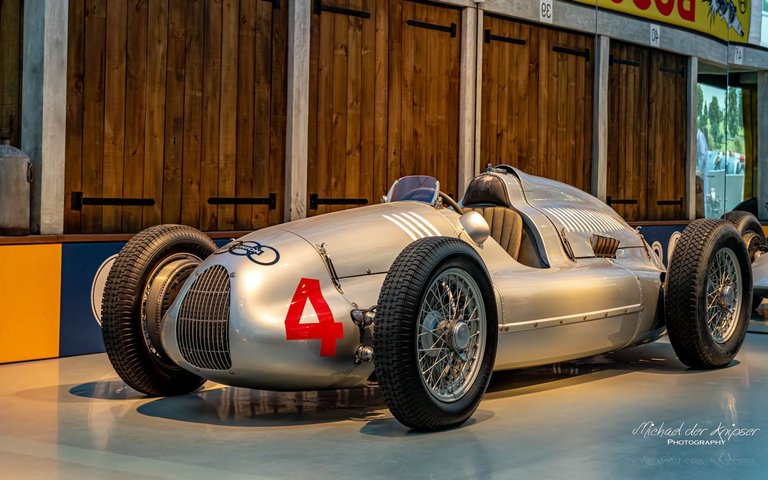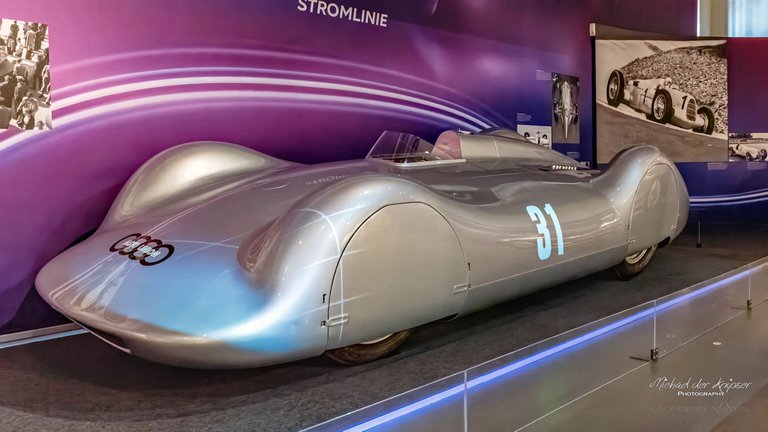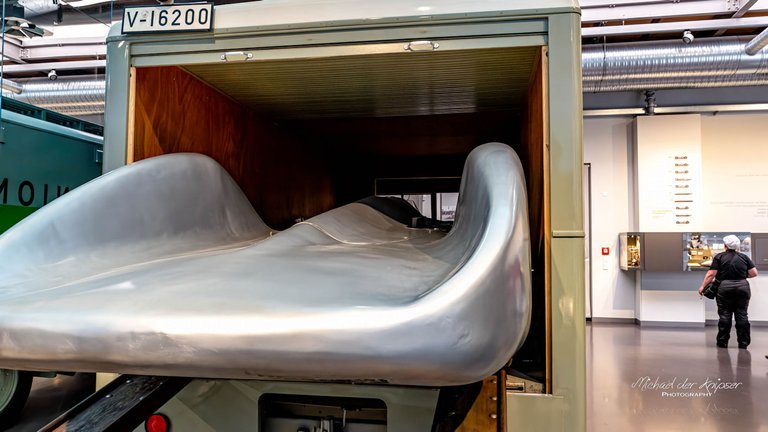[Fotoblog] Auto Union Rennwagen Typ C (DE/EN)
Hallo zusammen,
Der Auto Union Grand Prix Rennwagen Typ C war zweifellos ein Meisterwerk der deutschen Ingenieurskunst und ein Symbol für die außerordentliche Leistungsfähigkeit der Auto Union. Entwickelt von Ferdinand Porsche und erstmals 1934 in Rennen eingesetzt, markierte der Typ C den Höhepunkt in der Entwicklung des Rennwagens nach der 750-kg-Formel. Mit seinem beeindruckenden 16-Zylinder-Mittelmotor und einem Hubraum von 4,5 Litern war der Typ C in der Lage, eine Leistung von 445 PS zu erreichen. Diese immense Kraft ermöglichte es dem Fahrzeug, Geschwindigkeiten von über 300 km/h zu erreichen, was zu dieser Zeit absolut beeindruckend war. Das aerodynamische Design des Typ C trug ebenfalls dazu bei, seine Leistungsfähigkeit zu maximieren. Durch geschickte Gestaltung und innovative Lösungen wurde der Luftwiderstand minimiert und die Fahrstabilität verbessert. Dies ermöglichte es den Fahrern, das volle Potenzial des Fahrzeugs auszuschöpfen und in den Rennen zu glänzen.
The Auto Union Grand Prix racing car Type C was undoubtedly a masterpiece of German engineering and a symbol of Auto Union's extraordinary performance. Developed by Ferdinand Porsche and first used in races in 1934, the Type C marked the pinnacle in the development of the racing car based on the 750 kg formula. With its impressive 16-cylinder mid-engine and a displacement of 4.5 liters, the Type C was capable of achieving an output of 445 hp. This immense power allowed the vehicle to reach speeds of over 300 km/h, which was absolutely impressive at the time. The aerodynamic design of the Type C also helped to maximize its performance. Clever design and innovative solutions minimized drag and improved driving stability. This allowed drivers to exploit the vehicle's full potential and excel in races.

(60 mm; f/8; 1/60 sek.; ISO 2000)
Kamera: Nikon D750, Objektive: Tamron 24-70 mm f2.8
Der Typ C war nicht nur ein technologisches Meisterwerk, sondern auch äußerst erfolgreich in der Rennszene. Mit zahlreichen Siegen bei renommierten Rennen wie dem Großen Preis von Deutschland und der Targa Florio etablierte er sich als einer der dominierenden Rennwagen seiner Zeit. Der Einfluss des Typ C auf die nachfolgende Generation von Rennwagen kann nicht unterschätzt werden. Sein innovatives Design und seine herausragende Leistung setzten neue Maßstäbe und beeinflussten die Entwicklung des Motorsports nachhaltig. Der Auto Union Grand Prix Rennwagen Typ C bleibt ein unvergessliches Kapitel in der Geschichte des Motorsports und ein lebendiges Symbol für deutsche Ingenieurskunst, technische Innovation und die Leidenschaft für das Rennfahren.
The Type C was not only a technological masterpiece, but also extremely successful on the racing scene. With numerous victories in prestigious races such as the German Grand Prix and the Targa Florio, it established itself as one of the dominant racing cars of its time. The influence of the Type C on the following generation of racing cars cannot be underestimated. Its innovative design and outstanding performance set new standards and had a lasting influence on the development of motorsport. The Auto Union Grand Prix Type C racing car remains an unforgettable chapter in the history of motorsport and a living symbol of German engineering, technical innovation and a passion for racing.

(38 mm; f/8; 1/60 sek.; ISO 1000)
Kamera: Nikon D750, Objektive: Tamron 24-70 mm f2.8
Die Silberpfeile der Auto Union und ihre Stromlinienform waren untrennbar miteinander verbunden und trugen maßgeblich zu ihrem Erfolg bei. Die Auto Union war eine der ersten Automobilhersteller, die erkannten, dass eine aerodynamische Karosserieform die Leistung und Geschwindigkeit eines Rennwagens entscheidend verbessern konnte. Durch das geschwungene Design und die glatte Oberfläche wurde der Luftwiderstand minimiert und die Fahrstabilität verbessert. Dies ermöglichte es den Fahrern, höhere Geschwindigkeiten zu erreichen und die Rennen mit mehr Kontrolle zu fahren. Das Ergebnis war eine Karosserie, die nicht nur ästhetisch ansprechend war, sondern auch die Leistungsfähigkeit der Fahrzeuge deutlich steigerte.
Auto Union's Silver Arrows and their streamlined shape were inextricably linked and contributed significantly to their success. Auto Union was one of the first car manufacturers to recognize that an aerodynamic body shape could significantly improve the performance and speed of a racing car. The curved design and smooth surface minimized drag and improved driving stability. This allowed drivers to reach higher speeds and race with more control. The result was a body that was not only aesthetically pleasing, but also significantly improved the performance of the vehicles.

(36 mm; f/8; 1/60 sek.; ISO 12800)
Kamera: Nikon D750, Objektive: Tamron 24-70 mm f2.8
Die Silberpfeile der Auto Union mit ihrer Stromlinienform waren nicht nur schnell, sondern auch äußerst erfolgreich in der Rennszene. Sie gewannen zahlreiche Rennen und etablierten sich als führende Rennwagen ihrer Zeit. Berühmte Fahrer wie Bernd Rosemeyer und Hans Stuck fuhren den Auto Union Typ C und trugen zu zahlreichen Siegen in Rennen wie der Grand-Prix-Saison bei. Besonders bemerkenswert war der Sieg von Bernd Rosemeyer beim Großen Preis von Deutschland 1936. Die Silberpfeile der Auto Union und auch die von Mercedes-Benz prägten eine Ära des Grand-Prix-Rennsports und waren sowohl technisch als auch ästhetisch wegweisend. Der Begriff „Silberpfeile“ wurde oft verwendet, um die deutschen Rennwagen dieser Ära zu beschreiben, unabhängig davon, ob sie von Mercedes-Benz oder der Auto Union stammten.
The Auto Union Silver Arrows with their streamlined shape were not only fast, but also extremely successful on the racing scene. They won numerous races and established themselves as the leading racing cars of their time. Famous drivers such as Bernd Rosemeyer and Hans Stuck drove the Auto Union Type C and contributed to numerous victories in races such as the Grand Prix season. Bernd Rosemeyer's victory in the 1936 German Grand Prix was particularly notable. The Silver Arrows of Auto Union and also those of Mercedes-Benz shaped an era of Grand Prix racing and were pioneering both technically and aesthetically. The term "Silver Arrows" was often used to describe the German racing cars of this era, regardless of whether they came from Mercedes-Benz or Auto Union.

(26 mm; f/8; 1/60 sek.; ISO 1000)
Kamera: Nikon D750, Objektive: Tamron 24-70 mm f2.8
Im Horch Museum in Zwickau hatte ich die einzigartige Möglichkeit, diese Rennwagen der Auto Union Typ C hautnah zu erleben und auch zu fotografieren. Dieser historische Rennwagen ist ein wahrer Schatz der Automobilgeschichte und ein Symbol für deutsche Ingenieurskunst und Motorsportleidenschaft. Neben dem Auto Union Typ C bietet das Horch Museum auch eine Vielzahl weiterer historischer Fahrzeuge, darunter Modelle von Horch, Audi, DKW und Wanderer. Es ist ein Ort, an dem Automobilgeschichte lebendig wird und Besucherinnen und Besucher in vergangene Epochen eintauchen können. Das Horch Museum in Zwickau ist ein absolutes Muss für alle Automobil- und Motorsportfans.
At the Horch Museum in Zwickau, I had the unique opportunity to experience and photograph these Auto Union Type C racing cars up close. This historic racing car is a true treasure of automotive history and a symbol of German engineering and passion for motorsport. In addition to the Auto Union Type C, the Horch Museum also offers a variety of other historic vehicles, including models from Horch, Audi, DKW and Wanderer. It is a place where automotive history comes to life and visitors can immerse themselves in bygone eras. The Horch Museum in Zwickau is an absolute must for all automobile and motorsport fans.

(30 mm; f/8; 1/60 sek.; ISO 2800)
Kamera: Nikon D750, Objektive: Tamron 24-70 mm f2.8
Bei der ganzen Eufonie für diesen Rennwagen darf man die politische Geschichte nicht vergessen. Die Entwicklung des Auto Union Typ C fand während der Zeit des Nationalsozialismus in Deutschland statt. Die Auto Union war Teil der nationalsozialistischen Wirtschaftspolitik, die auf die Förderung der deutschen Industrie und Technologie abzielte. Der Auto Union Typ C war nicht nur ein erfolgreicher Rennwagen, sondern symbolisierte auch den technologischen Fortschritt und die Ingenieurskunst Deutschlands. Die Erfolge im Motorsport wurden oft für propagandistische Zwecke genutzt, um die Überlegenheit der deutschen Industrie zu demonstrieren. Ein bemerkenswertes Ereignis in der Rennhistorie des Auto Union Typ C war der Große Preis von Deutschland 1936 auf der Avus-Rennstrecke in Berlin. Bernd Rosemeyer gewann das Rennen in einem Auto Union Typ C, was zu nationalen Feierlichkeiten und Stolz führte. Dieser Sieg wurde von den Nationalsozialisten als Triumph gefeiert.
In all the euphoria for this racing car, the political history must not be forgotten. The development of the Auto Union Type C took place during the National Socialist era in Germany. The Auto Union was part of the National Socialist economic policy aimed at promoting German industry and technology. The Auto Union Type C was not only a successful racing car, but also symbolized Germany's technological progress and engineering prowess. Successes in motorsport were often used for propaganda purposes to demonstrate the superiority of German industry. One notable event in the racing history of the Auto Union Type C was the 1936 German Grand Prix on the Avus racetrack in Berlin. Bernd Rosemeyer won the race in an Auto Union Type C, leading to national celebrations and pride. This victory was celebrated as a triumph by the National Socialists.

(50 mm; f/8; 1/60 sek.; ISO 900)
Kamera: Nikon D750, Objektive: Tamron 24-70 mm f2.8
Die Auto Union Typ C Rennwagen sind also historische Artefakte, die in die politische und gesellschaftliche Geschichte Deutschlands in den 1930er Jahren eingebettet sind. Während sie technologische Erfolge feierten, spiegeln sie auch die politischen Kontexte und Herausforderungen dieser Zeit wider. Der Typ C Rennwagen ist, so gesehen, ein historisches Artefakt aus der Zeit der 1930er Jahre, und es handelt sich dabei um ein bedeutendes Stück deutscher Automobilgeschichte. Diese Rennwagen repräsentieren nicht nur technologischen Fortschritt und Motorsporterfolge, sondern sind auch in die politischen und gesellschaftlichen Kontexte ihrer Zeit eingebettet.
The Auto Union Type C racing cars are therefore historical artifacts that are embedded in the political and social history of Germany in the 1930s. While they celebrated technological successes, they also reflect the political contexts and challenges of the time. The Type C racing car is, in this sense, a historical artifact from the 1930s era, and it is a significant piece of German automotive history. These racing cars not only represent technological progress and motorsport successes, but are also embedded in the political and social contexts of their time.

Bei dem Museumsbesuch in Zwickau habe ich sehr viel Geschichte erlebt und auch viel dazugelernt. Museen, insbesondere solche mit einem Fokus auf Automobilgeschichte wie das Horch Museum in Zwickau, bieten oft eine faszinierende Möglichkeit, in vergangene Epochen einzutauchen und mehr über die Entwicklung von Technologie, Gesellschaft und Kultur zu erfahren. Die Auto-Union Typ C Rennwagen, sowie andere Exponate in Museen, sind nicht nur faszinierende technologische Artefakte, sondern sie erzählen auch Geschichten über die Menschen, die an ihrer Entwicklung beteiligt waren, die Zeit, in der sie entstanden sind, und ihre Auswirkungen auf die Gesellschaft. Es macht mir auch riesigen Spaß, diese Geschichte auf ein Foto festzuhalten. Das war es, wieder einmal von mir und ich wünsche euch noch einen schönen Tag.
During my visit to the museum in Zwickau, I experienced a lot of history and also learned a lot. Museums, especially those with a focus on automotive history such as the Horch Museum in Zwickau, often offer a fascinating opportunity to immerse yourself in past eras and learn more about the development of technology, society and culture. The Auto-Union Type C racing cars, as well as other exhibits in museums, are not only fascinating technological artifacts, but they also tell stories about the people who were involved in their development, the time in which they were created and their impact on society. I also really enjoy capturing this history in a photograph. That's it, once again from me, and I hope you have a great day.
Euer
Hornet on Tour

Instagram: https://www.instagram.com/hornet_on_tour/
Twitter: https://twitter.com/OnHornet
Photo: Hornet on Tour (Michael der Knipser)
Translated with www.DeepL.com/Translator (free version)
Mit Hilfe von LanguageTool Ihr Schreibassistent (Grammatik- und Rechtschreibprüfung)
Cars are more like flying machines. UFOs ;)
!BBH !PIZZA !PGM
BUY AND STAKE THE PGM TO SEND A LOT OF TOKENS!
The tokens that the command sends are: 0.1 PGM-0.1 LVL-0.1 THGAMING-0.05 DEC-15 SBT-1 STARBITS-[0.00000001 BTC (SWAP.BTC) only if you have 2500 PGM in stake or more ]
5000 PGM IN STAKE = 2x rewards!
Discord
Support the curation account @ pgm-curator with a delegation 10 HP - 50 HP - 100 HP - 500 HP - 1000 HP
Get potential votes from @ pgm-curator by paying in PGM, here is a guide
I'm a bot, if you want a hand ask @ zottone444
@hornet-on-tour! Your Content Is Awesome so I just sent 1 $BBH (Bitcoin Backed Hive) to your account on behalf of @dotwin1981. (16/50)
$PIZZA slices delivered:
@dotwin1981(13/15) tipped @hornet-on-tour
Great shots! These are some cool looking vehicle designs.
You said it, it's hard to believe that this vehicle is around 90 years old. You can't walk past it without capturing it in a photo. Greetings Michael
A beast! I watched a video on the Type C recently, that double-wheeled hill climb version. Those cars were indeed insane for their era, and quite dangerous to drive as well.
It is very impressive when you can see them live. In fact, these racing cars were very dangerous, I wouldn't necessarily want to drive them.
Fast, no seat belt, no helmet, wearing just a shirt and goggles 🤣
🤣